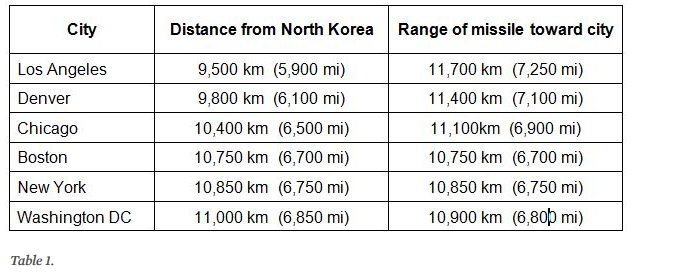The missile was launched nearly vertically, traveled 1000 kilometers and reached an altitude of about 3000 kilometers before splashing down off the coast of Japan, according to the Japanese national broadcaster NHK. Other reports suggest that altitude may have been even higher.
If those numbers are correct, the missile flown on a standard trajectory the missile would have a range 10,400 km (6,500 miles), not taking into account the Earth’s rotation. David Wright, physicist and co-director of the UCS Global Security Program, is an established expert on the technical aspects of arms control, particularly those related to missile defense systems, missile proliferation, and space weapons provided the estimates for the Union of Concerned Scientists.
The rotation of the Earth increases the range of missiles fired eastward, depending on their direction. Calculating the range of the missile in the direction of some major US cities gives the approximate results in Table 1.

We do not know the mass of the payload the missile carried on this test. If it was lighter than the actual warhead the missile would carry, the ranges would be shorter than those estimated above.
“It’s pretty surprising to me that this was so much longer range than their last test. We don’t know yet whether they did something to change the missile or what payload they were carrying, so it’s still pretty mysterious,” says Wright. They could have reduced the mass of the mock warhead on the ICBM to get a longer range, rather than improving the rocket itself, he says.

Brian Wang is a Futurist Thought Leader and a popular Science blogger with 1 million readers per month. His blog Nextbigfuture.com is ranked #1 Science News Blog. It covers many disruptive technology and trends including Space, Robotics, Artificial Intelligence, Medicine, Anti-aging Biotechnology, and Nanotechnology.
Known for identifying cutting edge technologies, he is currently a Co-Founder of a startup and fundraiser for high potential early-stage companies. He is the Head of Research for Allocations for deep technology investments and an Angel Investor at Space Angels.
A frequent speaker at corporations, he has been a TEDx speaker, a Singularity University speaker and guest at numerous interviews for radio and podcasts. He is open to public speaking and advising engagements.

